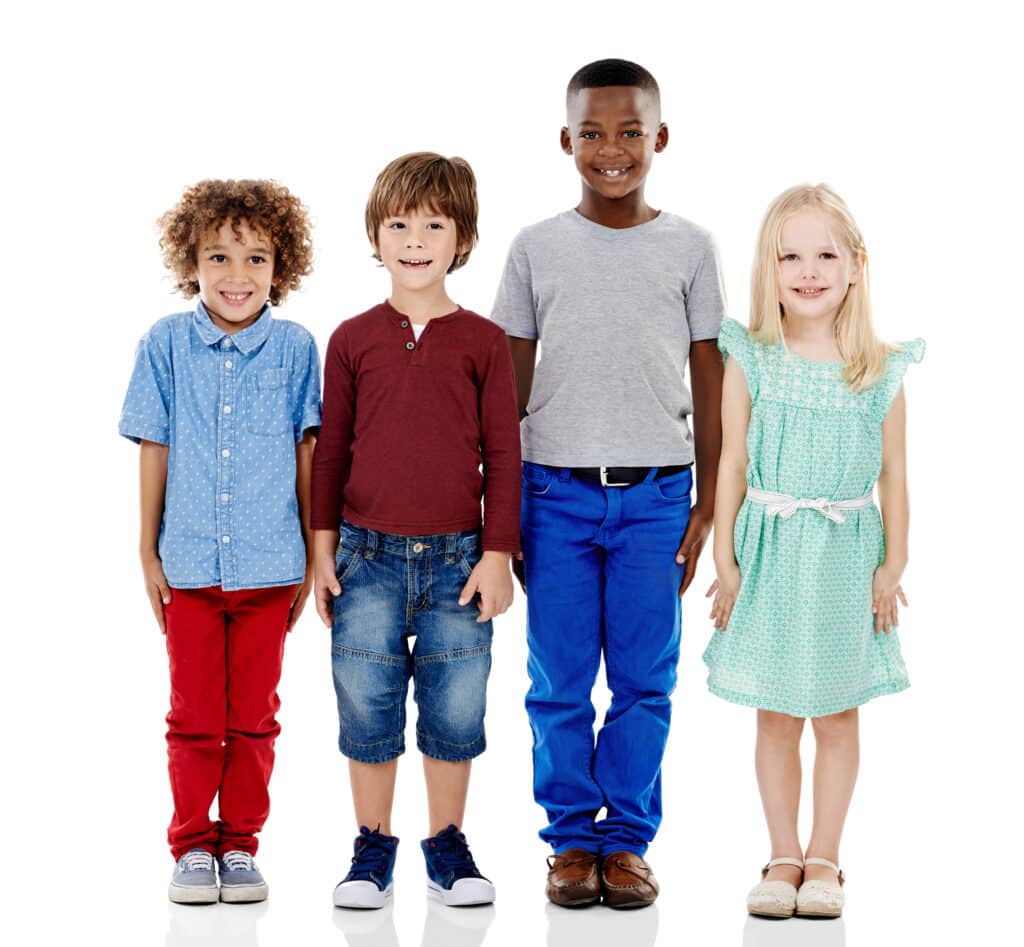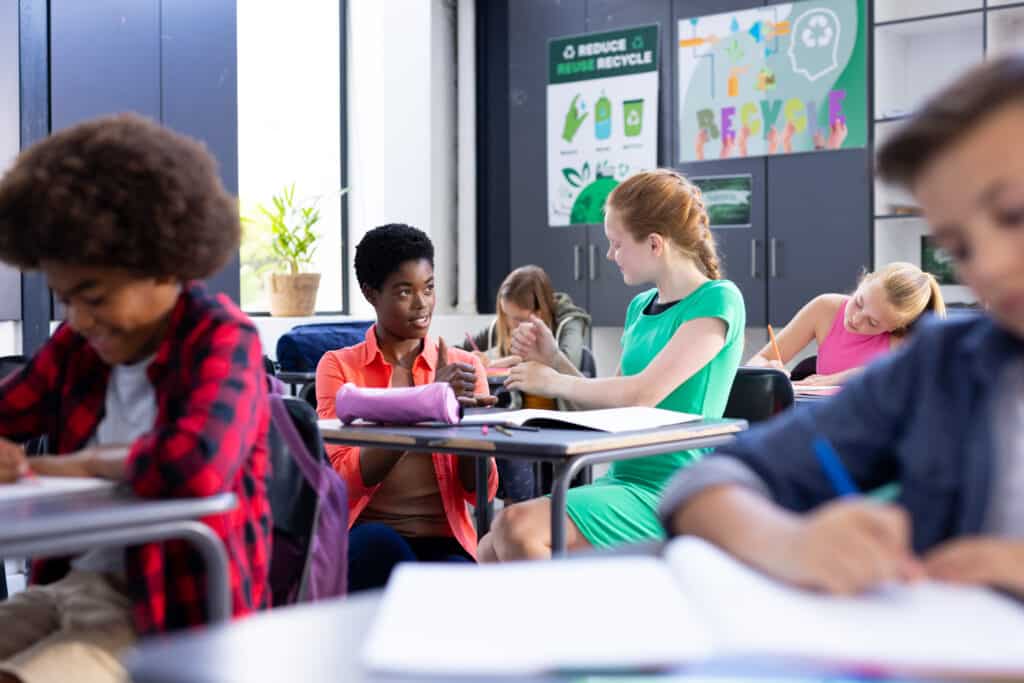
Why Gifted Students Have Unique Needs
Let’s start this discussion with why gifted kids often have a different social and emotional journey compared to their classmates. It’s not just about being smart – there’s a whole lot more going on! It’s not just better thinking – it’s different thinking, and that affects more than their brains.
I’m sharing a lot from my own experience as an experienced educator, a gifted student, the parent of gifted children, and the former Youth & Education Ambassador for Mensa. I’m also sharing lots of references to the peer-reviewed research of others (cited at the bottom of the article).
So let’s look at five common traits of gifted children that makes their social and emotional life complicated.
- Feeling Things Deeply: Gifted kids tend to be like emotional sponges. They might get super worked up about things like fairness, have wild imaginations, or ask big life questions way earlier than you’d expect. They get worked up and worried quickly. They soak that emotion up super fast, and then they wring it all out. They go to DEFCON1.
- Growing Unevenly: Imagine your brain is racing ahead while the rest of you is trying to catch up. It can be like a car trying to drive in the wrong gear for the speed. That’s what it’s like for many gifted kids. They might perform in some areas light years ahead of what we’d expect, but still have the social skills of their age (or even lower). This is called asynchronous development (read more about it in the next section).
- Feeling Like an Outsider: It can be tough for gifted kids to find friends who ‘get’ them. Their cognitive peers are not usually their chronological peers. They might be ready for deep conversations when their classmates just want to play tag. Also, does anyone care about dinosaurs the way almost every gifted kids KNOWS dinosaurs deserve to be cared about? This can make them feel pretty lonely sometimes.
- Doubting Themselves: Even though they’re smart, gifted kids often worry they’re not good enough. They might feel pressure to be perfect all the time, which can lead to a lot of stress and fear of messing up. This can be full-blown perfectionis or imposter syndrome, or it can be more subtle, creeping into their daily lives like death by a thousand paper cuts.
- Unique Brain Quirks: I live in Texas, and you will often see tshirts saying, “Keep Austin Weird.” If gifted kids had a shirt saying, “Keep Gifted Kids Weird,” everyone would yawn because really, are they in any danger of NOT being a little weird? Nope. They’re quirky. They’re a little odd. That’s okay, it really is, but it’s a thing.
So, gifted kids aren’t just mini-adults – they’ve got their own special mix of awesome abilities and tricky challenges. Understanding this helps us give them the support they need to thrive at home and in school.
Understanding Asynchronous Development
Asynchronous development is a fascinating concept that’s really central to understanding gifted children. Essentially, it refers to the uneven or out-of-sync development across different domains – like cognitive, emotional, social, and physical development.
A gifted child might have the intellectual capacity of someone much older, but the emotional maturity of their actual age or even younger. As you can imagine, this can create some interesting challenges for parents, peers, and teachers.
Dr. Linda Silverman, a leading researcher in this area, describes it as gifted children being “many ages at once.”
In one of her studies, she found that the more intellectually gifted a child is, the more pronounced this asynchrony tends to be (Silverman, 1997).
This mismatch between intellectual and emotional development can have a big impact on both learning and emotional well-being.
On the learning side, gifted kids may get frustrated when their abilities outpace the curriculum, leading to boredom or acting out.
Emotionally, they may struggle to connect with same-age peers or grapple with complex ideas their emotions aren’t quite ready to handle.
A study by Anne-Marie Roeper (1982) found that gifted children often experience intense emotions and sensitivities as part of their asynchronous development.
This emotional intensity can be both a strength and a challenge.
More recently, research by Jen Merrill (2012) has highlighted how asynchronous development can affect social relationships for gifted kids.
They may seek out older children or adults as intellectual peers, but lack the social skills to navigate those interactions smoothly.
The key takeaway is that we need to look at gifted children holistically, not just focus on their cognitive abilities.
Supporting their social and emotional growth is just as important as challenging them academically.

Common Social and Emotional Challenges of Gifted Students
Bullying, perfectionism, isolation, and emotional intensities are interconnected issues that often affect gifted children, creating a complex web of challenges for these young minds.
Bullying is unfortunately a common experience for many gifted children. I speak about it at length in one of my keynote speeches, where I talk about the impact bullying had on me when I was seven.
A study by Peterson and Ray found that a staggering 67% of gifted students had experienced bullying by eighth grade.
This high prevalence is particularly concerning because gifted children may be more vulnerable to the emotional impacts of bullying due to their heightened sensitivities and intensities.
Speaking of intensities, gifted children often experience what Dabrowski termed “overexcitabilities” – heightened responses to various stimuli.
These can manifest as emotional intensity, psychomotor intensity, heightened imagination, intellectual curiosity, or sensory sensitivity.
While these traits can be strengths, they can also make gifted kids stand out from their peers, potentially making them targets for bullying.
Perfectionism is another common trait among gifted children that can complicate their social and emotional lives. I’ve written about this extensively, including in my book, Perfectionism: A Practical Guide to Managing “Never Good Enough.”
The high expectations they place on themselves (and that others place on them) can lead to stress and anxiety.
When combined with bullying, this perfectionism can exacerbate feelings of inadequacy or failure.
Isolation is often a byproduct of these other factors.
As I discussed earlier, gifted children may struggle to find peers who share their interests or can engage with them at their intellectual level.
This can lead to feelings of loneliness and social isolation.
Additionally, if they’re being bullied, they might withdraw from social situations as a protective measure.
It’s crucial to note that these issues can have serious consequences.
The same study by Peterson and Ray found that 29% of bullied gifted students had violent thoughts. This statistic underscores the importance of addressing these issues promptly and effectively.
However, it’s not all doom and gloom. Gifted children often have strengths that can help them cope with these challenges.
For instance, many gifted students understand that bullies are motivated by external factors like insecurity or anger. This insight may help them depersonalize the bullying to some extent.
I chose this picture below because the little girl reminded me so much of myself – alone and wanting so badly to fit in.

The Classroom as a Safe Haven
One of the key aspects of a supportive environment is fostering a sense of belonging.
As I’ve already discussed, gifted kids often feel like they don’t quite fit in with their age peers, which can lead to isolation and loneliness.
A study by Cross et al. (2018) found that gifted students who felt a strong sense of belonging in their school environment reported higher levels of self-esteem and lower levels of anxiety and depression.
So, how can we create this sense of belonging?
One effective strategy is to provide opportunities for gifted students to connect with like-minded peers.
This could involve setting up small group projects where students with similar interests can work together, or creating a “genius hour” where kids can pursue passion projects and share their expertise with classmates.
While I’m not a fan of the term “passion projects,” I like the idea of normalizing being really excited about something others may not have any interest in.
Another important element of a supportive classroom is challenging curriculum that matches the gifted student’s abilities. With gifted kids, you cannot separate their cognitive needs from their social and emotional needs. They very much influence each other.
Boredom is the enemy of engagement, and gifted kids who aren’t appropriately challenged may act out or disengage from learning.
A study by Plucker and Callahan (2014) found that gifted students in classrooms with differentiated instruction showed greater academic growth and reported higher levels of motivation compared to those in traditional classrooms.
Here’s a practical example: Let’s say you’re teaching a unit on ecosystems. While the rest of the class is learning basic concepts, you might give your gifted students a more complex task, like designing a sustainable ecosystem for a Mars colony.
This kind of open-ended, challenging project can keep gifted kids engaged and excited about learning.
The simple rule: Get gifted kids to the Application level of thinking as quickly as possible.
It’s also crucial to address the social-emotional needs of gifted students directly.
We’ve already noted that many gifted kids struggle with perfectionism, impostor syndrome, or anxiety.
Creating a classroom culture that values effort over perfection and encourages risk-taking can help alleviate some of these issues.
You might share stories of famous inventors or scientists who failed many times before succeeding or implement a “mistake of the week” celebration where students share what they learned from a recent error.
Lastly, don’t underestimate the power of simply listening and validating gifted students’ experiences.
Many gifted kids feel misunderstood or out of place.
By showing that you understand and appreciate their unique perspectives and challenges, you can help them feel seen and supported.
Remember, a supportive classroom environment isn’t just about academic achievement – it’s about nurturing the whole child. By addressing the psychosocial needs of gifted students, we can help them thrive both in and out of the classroom.

Practical Strategies for Educators
I’ve got specific tips for teachers working with gifted students. (Note: If you’re looking for this in the Social and Emotional Needs of the Gifted course, they’re in Module 1.)
- Be consistent
Consistency is key when working with gifted children. They often have a keen sense of fairness and can become frustrated if rules or expectations seem to change arbitrarily. Establish clear guidelines and stick to them. This doesn’t mean being inflexible, but rather providing a stable framework within which gifted students can thrive.
A study by Siegle and McCoach (2005) found that gifted students respond well to consistent, high expectations from teachers. They noted that “when teachers consistently communicate high expectations for all students, gifted students are more likely to remain engaged and motivated.”
- Maintain momentum
Gifted students often process information quickly and can become bored or disruptive if the pace of instruction is too slow. Try to keep lessons moving at a brisk pace, providing additional challenges for students who finish early.
Reis and Renzulli (2010) suggest using curriculum compacting, which allows gifted students to skip material they’ve already mastered and move on to more challenging content. This helps maintain momentum and keeps gifted students engaged.
- Discover their interests
Gifted children often have intense, specific interests. Tapping into these can be a powerful motivator. Allow students to pursue projects related to their passions, or use their interests as a springboard for learning in other areas.
Renninger and Hidi (2016) found that interest plays a crucial role in learning and motivation for all students, but especially for gifted learners. They suggest that “teachers who can identify and nurture student interests can significantly enhance engagement and achievement.”
- Avoid group punishment
While it might be tempting to punish the whole class for the misbehavior of a few, this can be particularly demotivating for gifted students who often hold themselves to high standards. Instead, address issues with individual students privately.
Delisle and Galbraith (2002) argue that group punishment can be especially harmful to gifted students, potentially leading to resentment and disengagement from school.
- Discipline privately if at all possible
When discipline is necessary, try to handle it privately. Gifted students can be sensitive to criticism and may feel deeply embarrassed by public reprimands. A quiet word after class can often be more effective than calling out a student in front of their peers.
Cross (2011) notes that gifted students often have heightened sensitivities and may react more strongly to public criticism than their peers. Private conversations can help maintain the student’s dignity while addressing behavioral issues.
- Don’t surrender leadership
While it’s great to give gifted students opportunities to lead and share their knowledge, remember that you’re still the teacher. Gifted students need guidance and structure just like any other students. Maintain your role as the classroom leader while providing opportunities for student autonomy and leadership within that framework.
Kanevsky and Keighley (2003) found that gifted students respect teachers who can maintain authority while still providing challenging and engaging instruction.
They suggest that “effective teachers of gifted students are those who can balance structure and flexibility, providing guidance while allowing for student autonomy.”
That last piece of advice is so critical. Balance structure and flexibility. It’s hard as a parent, and it is hard as a teacher.
The key is to remain flexible and responsive to individual needs while maintaining a structured and engaging classroom environment.
Remember, these are general guidelines and every gifted child is unique. Hopefully, these ideas will be helpful to you.

Why It’s Time to Take Action
Understanding the social and emotional needs of gifted children is absolutely crucial for both teachers and parents. Real, lasting damage can be done when their needs are ignored, even unintentionally.
As we’ve discussed here and the researchers have found over and over, these exceptional kids aren’t just academically advanced – they often experience the world differently, with heightened sensitivities and intensities that can make navigating social and emotional landscapes challenging.
By learning about these unique needs, we can better support gifted children in their overall development.
We can help them build resilience, manage perfectionism, cope with asynchronous development, and find peers who truly “get” them.
This knowledge allows us to create environments where gifted kids can thrive, not just academically, but socially and emotionally as well.
If you’re a teacher or parent of a gifted child, I strongly encourage you to dive deeper into this topic.
I offer a course for teachers on the social and emotional needs of gifted children (if you’re a parent, you’re welcome to take it, too). It’s an investment that can pay dividends in your student’s well-being and future success. Learn more here.
Remember, giftedness isn’t just about high IQ scores or academic achievement. It’s a whole-child experience that affects every aspect of a child’s life.
By understanding and addressing their social and emotional needs, we can help gifted children develop into well-rounded, happy, and successful adults.
A bonus: you’ll save yourself a lot of frustration!
Gifted children are a true joy, and the most joy is found when they are deeply understood.

You May Also Like these Articles & Resources:
- How to Tell a Child He/She is Gifted
- Supporting Overly Emotional Children
- My Gifted Anti-Bucket List
- Misdiagnosis of Gifted Children Demystified
- My book on perfectionism
- The course on the Social and Emotional Needs of Gifted Children
References:
Cross, J. R., Bugaj, S. J., & Mammadov, S. (2016). Accepting a scholarly identity: Gifted students, academic crowd membership, and identification with school. Journal for the Education of the Gifted, 39(1), 23-48.
Cross, T. L. (2011). On the social and emotional lives of gifted children. Prufrock Press Inc.
Cross, T. L., Cassady, J. C., Dixon, F. A., & Adams, C. M. (2008). The psychology of gifted adolescents as measured by the MMPI-A. Gifted Child Quarterly, 52(4), 326-339.
Delisle, J., & Galbraith, J. (2002). When gifted kids don’t have all the answers. Free Spirit Publishing.
Kanevsky, L., & Keighley, T. (2003). To produce or not to produce? Understanding boredom and the honor in underachievement. Roeper Review, 26(1), 20-28.
Merrill, J. (2012). Social and emotional issues: The gifted child’s perspective. Gifted Child Today, 35(2), 144-145.
Peterson, J. S., & Ray, K. E. (2006). Bullying among the gifted: The subjective experience. Gifted Child Quarterly, 50 (3), 252-269.
Peterson, J. S., & Ray, K. E. (2006). Bullying and the gifted: Victims, perpetrators, prevalence, and effects. Gifted Child Quarterly, 50 (2), 148-168.
Plucker, J. A., & Callahan, C. M. (2014). Research on giftedness and gifted education: Status of the field and considerations for the future. Exceptional Children, 80(4), 390-406.
Reis, S. M., & Renzulli, J. S. (2010). Is there still a need for gifted education? An examination of current research. Learning and Individual Differences, 20(4), 308-317.
Renninger, K. A., & Hidi, S. E. (2016). The power of interest for motivation and engagement. Routledge.
Roeper, A. (1982). How the gifted cope with their emotions. Roeper Review, 5(2), 21-24.Silverman, L. K. (1997).
Siegle, D., & McCoach, D. B. (2005). Motivating gifted students. Prufrock Press Inc.
Silverman, L. K. (1997). The construct of asynchronous development. Peabody Journal of Education, 72(3–4), 36–58.



